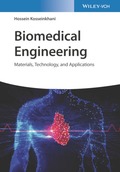Biomedical Engineering
Materials, Technology, and Applications

1. Auflage Dezember 2022
320 Seiten, Hardcover
5 Abbildungen (5 Farbabbildungen)
3 Tabellen
Monographie
ISBN:
978-3-527-34746-9
Wiley-VCH, Weinheim
Kurzbeschreibung
Covers key aspects of biomedical engineering, from basic concepts to advanced level research for medical and biomedical applications.
Jetzt kaufen
Preis: 149,00 €
Preis inkl. MwSt, zzgl. Versand
Euro-Preise für Wiley-VCH- und Ernst & Sohn-Titel sind nur für Deutschland gültig. In EU-Ländern gilt die lokale Mehrwertsteuer. Portokosten werden berechnet.
1. CONCEPTS of BIOMEDICAL ENGINEERING
1.1 Introduction
1.2 Frontiers in Biomedical Engineering
1.3 Impact of Biomedical Engineering
1.4 General Applications of Biomedical Engineering
1.5. Summary and Challenges
2. BIOMATERIALS
2.1 Introduction
2.2 Biodegradable Polymers
2.3 Natural Biomaterials
3. RECENT ADVANCES AND APPLICATIONS OF HYDROGELS IN MEDICINE
3.1 Introduction
3. 2 Glucose-Responsive Hydrogels
3.3 Protein-Responsive Hydrogels
3.4 Nucleic Acids-Responsive Hydrogel
3.5 Future Prospects
4. SELF-ASSEMBLED NANOMATERIALS
4.1 Introduction
4.2 Classification of Self-Assembled Systems
4.3 In Vitro Biological Approaches of Self-Assembled Systems
4.4 Future Prospects
5. CYTOTOXICITY OF MATERIALS
5.1 Introduction
5.2 Mechanisms of Toxicity
5.3 Toxicity Assessment of Nanomaterials
5.4 Physicochemical Properties of NPs Affecting Toxicity
5.5 Future Prospects
6. DRUG DELIVERY TECHNOLOGY
6.1 Introduction
6.2 Biodegradable Polymers in Drug Delivery
6.3 Target Drug Delivery
6.4 Drug Delivery in Imaging Technology
6.5 Summary and Challenges
7. EARLY STAGE DETECTION TECHNOLOGY
7.1 Introduction
7.2 Three Dimensional (3D) Materials for Biological Application
7.3 Current Approaches of Nanofabrication by Using Lithography
7.4 Future Approaches
8. REGENERATIVE MEDICINE
8.1 Introduction
8.2 Tissue Engineered Scaffolds
8.3 Specific Mediated Biomaterials
8.4 Summary and Challenges
9. NANOBIOTECHNOLOGY
9.1 Introduction
9.2 Classification of Nanomaterials
9.3 Future Prospects
10. 3D IN VITRO SYSTEMS
10.1 Introduction
10.2 Conventional 3D Technology
10.3 Advanced Techniques to Create 3D Systems
10.4 High-Throughput Screening (HTS) Technologies
10.5 Development of 3D In Vitro Cell Culture Technology
10.6 Future Prospects
11. FRONTIERS IN BIOMEDICAL ENGINEERING
11.1 Introduction
11.2 Personalized Medicine
11.3 Intelligent Biomaterials
11.4 Artificial Intelligence (AI)
11.5 Quality Assurance Statement of Biomaterials
11.6 Biohazard of Materials
11.7 Environmental, Health, and Safety Issues of Materials
11.8 Limitations of Materials in Medicine
11.9 Clinically-Approved Biomaterials
11.10 Future Prospects
1.1 Introduction
1.2 Frontiers in Biomedical Engineering
1.3 Impact of Biomedical Engineering
1.4 General Applications of Biomedical Engineering
1.5. Summary and Challenges
2. BIOMATERIALS
2.1 Introduction
2.2 Biodegradable Polymers
2.3 Natural Biomaterials
3. RECENT ADVANCES AND APPLICATIONS OF HYDROGELS IN MEDICINE
3.1 Introduction
3. 2 Glucose-Responsive Hydrogels
3.3 Protein-Responsive Hydrogels
3.4 Nucleic Acids-Responsive Hydrogel
3.5 Future Prospects
4. SELF-ASSEMBLED NANOMATERIALS
4.1 Introduction
4.2 Classification of Self-Assembled Systems
4.3 In Vitro Biological Approaches of Self-Assembled Systems
4.4 Future Prospects
5. CYTOTOXICITY OF MATERIALS
5.1 Introduction
5.2 Mechanisms of Toxicity
5.3 Toxicity Assessment of Nanomaterials
5.4 Physicochemical Properties of NPs Affecting Toxicity
5.5 Future Prospects
6. DRUG DELIVERY TECHNOLOGY
6.1 Introduction
6.2 Biodegradable Polymers in Drug Delivery
6.3 Target Drug Delivery
6.4 Drug Delivery in Imaging Technology
6.5 Summary and Challenges
7. EARLY STAGE DETECTION TECHNOLOGY
7.1 Introduction
7.2 Three Dimensional (3D) Materials for Biological Application
7.3 Current Approaches of Nanofabrication by Using Lithography
7.4 Future Approaches
8. REGENERATIVE MEDICINE
8.1 Introduction
8.2 Tissue Engineered Scaffolds
8.3 Specific Mediated Biomaterials
8.4 Summary and Challenges
9. NANOBIOTECHNOLOGY
9.1 Introduction
9.2 Classification of Nanomaterials
9.3 Future Prospects
10. 3D IN VITRO SYSTEMS
10.1 Introduction
10.2 Conventional 3D Technology
10.3 Advanced Techniques to Create 3D Systems
10.4 High-Throughput Screening (HTS) Technologies
10.5 Development of 3D In Vitro Cell Culture Technology
10.6 Future Prospects
11. FRONTIERS IN BIOMEDICAL ENGINEERING
11.1 Introduction
11.2 Personalized Medicine
11.3 Intelligent Biomaterials
11.4 Artificial Intelligence (AI)
11.5 Quality Assurance Statement of Biomaterials
11.6 Biohazard of Materials
11.7 Environmental, Health, and Safety Issues of Materials
11.8 Limitations of Materials in Medicine
11.9 Clinically-Approved Biomaterials
11.10 Future Prospects
Hossein Hosseinkhani received his Ph.D. degree in Polymer Chemistry from Kyoto University. Thereafter, he was offered the prestigious JSPS Fellowship of Japan at Institute for Frontier Medical Sciences, Kyoto University Hospital to extend his concepts and to develop stem cells technology based on drug delivery systems for tissue engineering applications. Dr. Hosseinkhani was selected as International Center for Young Scientists Research Fellow of Japan because of his creative research in biomaterials science fields. He was a Senior Research Fellow at the International Research Institute for Integrated Medical Sciences, Tokyo Women's Medical University, Japan, and a Visiting Scientist at the Center for Biomedical Engineering, Massachusetts Institute of Technology (MIT), USA. Dr. Hosseinkhani has broad experience in life sciences and is an expert in nanotechnology, biomaterials, drug delivery, 3D in vitro systems, bioreactor technology, and bioengineering stem cells technology. He has long experience in both academia and industry in biomedical engineering research and development, which includes several years of basic science research experience in a number of premier institutions related to the structure and function of biomaterials, and in polymer-based and mineral-based medical implants development in the medical device industry.


